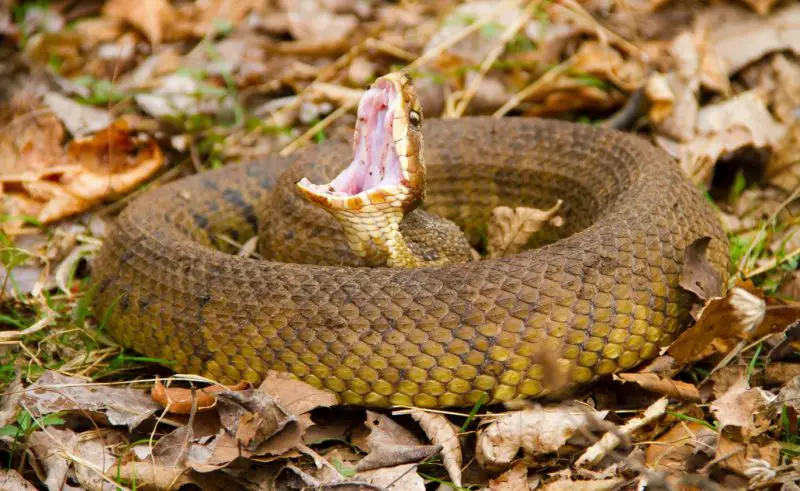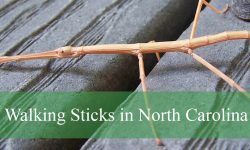Water moccasins often carry a reputation that overshadows their true nature. In the wetlands of Alabama, where countless species weave into the landscape, few animals inspire the same mix of interest and caution. These semi aquatic snakes have long been part of the region’s stories, moving quietly through cypress tunnels, shaded bayous, and the slow currents that shape the floodplain forests.
Much of what people believe about water moccasins is shaped by legend and half remembered stories. These snakes rarely behave the way most expect. They carry traits that help them survive in dark water and floating vegetation where visibility is low and competition is high. Understanding them demands patience and a willingness to look beyond assumptions.
This article explores hidden facts about water moccasins in Alabama’s wetlands. It uncovers their secret behaviors, their ecological roles, and the subtleties of their interactions with the environment. The deeper you go, the more surprising their world becomes.
Understanding the Water Moccasin

A Species Often Confused With Others
In Alabama, the term “water moccasin” refers specifically to the cottonmouth (Agkistrodon piscivorus). Many harmless water snakes share the same habitat, which leads to frequent misidentification. Cottonmouths have stockier bodies, triangular heads, and a distinctly vertical pupil. They also tend to hold their heavy form higher off the ground when disturbed.
Misidentification contributes to exaggerated stories that circulate around rural areas. People often assume any snake that touches water must be dangerous. This misunderstanding influences human wildlife interactions and has led to unnecessary killing of harmless species. Cottonmouths are venomous, but they are far from the aggressive animals they are rumored to be.
Learning how to tell them apart from non venomous water snakes helps reduce fear and supports healthier ecosystems. Alabama hosts a wide range of aquatic snakes, and each plays a role in controlling local animal populations.
Their Place Within Alabama’s Ecosystems
Cottonmouths thrive in swamps, oxbow lakes, marsh edges, and the shadowy undergrowth where water meets forest. Alabama’s subtropical climate provides the humidity and temperature stability they need. They function as mid level predators which means they help maintain balance between small mammals, amphibians, fish, and even other reptiles.
These snakes have adapted well to the state’s shifting hydrology. Seasonal flooding pushes nutrients and prey closer to shallow waters where cottonmouths hunt. Drought periods, on the other hand, force them to travel longer distances in search of food. Their ability to adjust behavior and movement patterns gives them a survival advantage.
Healthy cottonmouth populations signal stable wetland systems. When they thrive, it often means amphibians and fish populations are in good condition.
Hidden Behaviors in Alabama Wetlands
Nocturnal Patterns Few People Notice
Cottonmouths are far more active at night than during the day. Warm evenings allow the snake’s body temperature to remain stable without basking. This helps them avoid predators and reduce exposure to heat stress. Most people who claim these snakes are “everywhere” often see them only during dusk when their movements become more noticeable.
Night activity also gives cottonmouths an advantage over their prey. Frogs, fish, and small mammals rely on specific nighttime routines. Cottonmouths exploit these patterns by creeping silently along the edges of water channels. Their sensory pits detect faint temperature changes which helps them locate prey in near total darkness.
The nighttime world of Alabama wetlands is richer and louder than many realize. Cottonmouths move through it as invisible hunters.
The Mystery of the “Cottonmouth Display”
The cottonmouth display is one of the most recognizable behaviors in North American snakes. When threatened, the snake opens its mouth to reveal its pale interior. The white lining shows clearly in dim light which warns potential predators that the snake is dangerous. The display is more communication than aggression.
Many observers mistake this behavior for a sign that the snake is preparing to strike. In reality, it is a defensive message that says the snake wants distance. Cottonmouths use this display to avoid conflict, not to create it. The brighter the mouth appears the stronger the warning signal becomes.
This display is an adaptation perfectly suited to shadowy wetlands where visual cues are limited.
The Truth About Their Swimming Ability
Cottonmouths swim with their entire body floating on top of the water. This separates them from most non venomous water snakes which tend to keep only their head above the surface. However, people often exaggerate their swimming capabilities. Cottonmouths cannot chase boats or follow swimmers. They lack the motivation and metabolic support to pursue large animals in open water.
Most encounters occur when humans accidentally move into the snake’s hidden resting spots. Logs, marsh edges, and dense vegetation make perfect floating shelters. When disturbed, the snake typically moves away unless escape routes are blocked.
Their swimming style is efficient yet energy conscious which allows them to conserve resources during long periods of inactivity.
The Secret Diet of Water Moccasins
Opportunistic Feeding
Cottonmouths eat a surprisingly broad range of prey. Fish, frogs, crayfish, small birds, rodents, and even other snakes form part of their diet. This variety helps them survive seasonal shifts that influence prey availability. Alabama wetlands experience frequent water level changes which shape the abundance of fish and amphibians.
Cottonmouths adjust quickly by targeting whatever they encounter most easily. During spring, frog populations surge which provides abundant food. In summer heat when amphibians retreat, fish become a primary target. Winter diets shift toward slower moving prey such as small mammals that nest near water.
Their ability to adapt nutritionally supports long term survival.
Scavenging Behavior Rarely Discussed
One of the least known facts is that cottonmouths sometimes scavenge. They will eat dead fish or amphibians when necessary. This behavior is uncommon in most venomous snakes but gives cottonmouths an advantage during lean periods when fresh prey is difficult to capture.
Scavenging also removes decaying material from shallow waters which contributes to wetland cleanliness. Though subtle, this role benefits the overall ecosystem.
Silent Strike Techniques
Cottonmouths use ambush predation for many hunting situations. They wait in still positions among tree roots or submerged vegetation. When prey enters striking range the snake delivers a quick bite followed by release. They track their prey using both chemical cues and heat signatures.
Their venom contains enzymes that expedite digestion. This helps them process meals efficiently which is crucial in habitats where food may not always be guaranteed.
How Cottonmouths Communicate
Chemical Messaging in the Wetlands
Cottonmouths rely heavily on chemical cues. Their forked tongue gathers scent particles which are transferred to the Jacobson’s organ. This system provides information about prey, predators, and other snakes. Wetlands amplify chemical signals through moisture which creates a highly communicative environment.
These cues also guide cottonmouths during breeding seasons. Males follow scent trails to locate receptive females. The richness of Alabama’s wetlands enhances this communication network.
Vibrations and Body Language
Cottonmouths detect vibrations through their bodies which alerts them to approaching animals. They interpret these signals with surprising accuracy. Larger animals create deep vibrations while smaller prey produce subtler wave patterns. This ability allows cottonmouths to avoid danger before it becomes close.
Body language also plays a role. Slow tongue flicking, coiling patterns, and mouth displays communicate intent without unnecessary confrontation. Each gesture has meaning within the species.
Cottonmouth Reproduction Secrets
Courtship Behaviors Observed Only in Certain Seasons
During late spring and early summer males travel more frequently. Their movement patterns change dramatically as they search for mates. When a male finds a female he may perform a series of gentle nudges and contact movements that test her receptiveness. If she is not ready she signals by pulling away or flattening her body.
Competition between males can occur but is often less dramatic than people imagine. Fights consist mainly of pushing and entwining rather than biting. Venom is rarely used during these confrontations.
How Females Protect Their Young
Female cottonmouths give birth to live young which is unusual among reptiles. Newborns carry venom but are not aggressive. They rely on camouflage and instinct rather than parental care. However, females sometimes remain near the birthing site for several hours which provides a slight buffer against predators.
Juvenile cottonmouths have bright yellow tail tips used for luring frogs and small prey. This adaptation increases hunting success during their early life stages.
Cottonmouths and Local Alabama Myths
The Infamous “Chasing Behavior”
One of the most persistent myths claims cottonmouths chase humans. This story appears across the South yet lacks biological foundation. Cottonmouths are defensive reptiles. They move toward humans only when they feel blocked or startled. In cluttered wetlands escape paths are limited which may create the illusion of pursuit.
Snakes may also move in the same direction as humans briefly because both are seeking clear ground. This coincidence fuels misunderstanding.
Tales of Supernatural Aggression
Folklore sometimes paints cottonmouths as creatures that leap into boats or attack without warning. These legends likely grew from rare encounters in which snakes fell from low branches into canoes or were accidentally stepped on.
In reality cottonmouths avoid conflict whenever possible. They depend on conserving energy and prefer retreat over aggression. Their reputation is born more from fear than behavior.
Surviving in Alabama’s Harsh Wetlands
Thermoregulation in Unpredictable Weather
Alabama’s wetlands experience short periods of temperature fluctuation. Cottonmouths regulate their internal temperature using shaded areas, sunlit logs, or shallow water. Their ability to maintain stable body heat is essential for digestion and movement.
During cooler months they become sluggish and limit their daytime activity. Winter behavior varies depending on the wetland’s microclimate. Some snakes remain active on warmer days while others retreat deeper into sheltered vegetation.
Coping With Flood Cycles
Annual floods reshape wetland landscapes. Cottonmouths respond by relocating to higher ground or floating debris. These movements help them avoid drowning and allow them to hunt in new waters filled with displaced prey.
Their resilience is tied to Alabama’s dynamic hydrology. Floods renew the system and create feeding opportunities. Droughts concentrate prey in isolated pools which also favors the snakes.
Hidden Threats to Cottonmouth Populations
Habitat Loss
Urban expansion and altered water flow reduce the natural spaces cottonmouths depend on. Drainage of marshes, development of lakeside properties, and changes in forestry practices threaten the stability of their habitat.
Loss of wetland vegetation affects prey availability and shelter. Cottonmouths require complex ecosystems which means their populations decline when habitats simplify.
Human Conflict
Because cottonmouths are venomous they face immediate threats from human fear. Many are killed on sight despite posing little danger when left undisturbed. Road mortality also impacts their numbers. Snakes often cross warm pavement in search of food or mates which exposes them to vehicle collisions.
Educating the public about safe coexistence helps reduce unnecessary losses.
Pollution in Wetlands
Contaminants from agriculture and industry enter rivers and swamps. These chemicals accumulate in the food chain and weaken amphibian populations which cottonmouths rely on. Polluted waters also cause illness or reduced immune function in the snakes.
Healthy wetlands depend on clean water. Protecting this resource directly supports cottonmouth populations.
Interactions With Humans
Risks and Misunderstandings
Cottonmouths are venomous but bites are rare. Most incidents occur when a person attempts to handle the snake or accidentally steps on it. Their natural instinct is to flee or warn. Understanding this calm behavior helps prevent negative encounters.
When exploring wetlands it is wise to watch the ground carefully and avoid reaching into vegetation where visibility is low. Simple awareness reduces risk significantly.
Coexisting Safely
Residents who live near Alabama wetlands can coexist with cottonmouths by maintaining clear yards and avoiding leaving food scraps that attract rodents. Removing clutter and dense brush discourages snakes from sheltering too close to homes.
Cottonmouths remain valuable parts of local ecosystems. Respectful distance preserves both human safety and ecological balance.
Frequently Asked Questions
Are water moccasins aggressive in Alabama?
They are not aggressive by nature. Most defensive behavior occurs when the snake is startled or cornered. They prefer escape rather than confrontation.
Do cottonmouths chase people?
No. They do not pursue humans intentionally. Any appearance of chasing usually results from limited escape routes or confusion.
How dangerous is their venom?
Their venom is medically significant but rarely fatal with proper treatment. Most bites occur because the snake was handled or stepped on.
Where are cottonmouths most common in Alabama?
They are common in swamps, bayous, backwaters, marsh edges, and forested wetlands throughout the southern and central parts of the state.
Do water moccasins swim underwater?
They can swim both above and below the surface but prefer floating with their bodies visible. This helps them conserve energy.
What should I do if I encounter one on a trail?
Give the snake space and allow it to move away on its own. Most will retreat if not threatened.
What do baby cottonmouths eat?
Young cottonmouths primarily eat frogs, small fish, and insects. Their yellow tail tip helps attract prey.
How can I tell a cottonmouth from a harmless water snake?
Cottonmouths have a heavier build, triangular head shape, and vertical pupils. They also tend to keep their bodies afloat more fully when swimming.
Are cottonmouths active during winter in Alabama?
They are less active but may come out on warmer days. Winter behavior depends on local temperatures.
Do cottonmouths have predators?
Large birds, alligators, and some mammals may prey on them. Juveniles are more vulnerable than adults.
Final Thoughts
Alabama’s wetlands hide countless layers of biological complexity. Water moccasins are one of the species that reveal just how intricate these ecosystems can be. Their behaviors, adaptations, and ecological roles extend far beyond the stereotypes that follow them.
Understanding these snakes helps uncover the truth behind the myths. They are cautious, efficient, and deeply connected to the rhythms of their environment. By learning to appreciate their presence we gain insight into the health of Alabama’s wild landscapes and the importance of protecting them.






